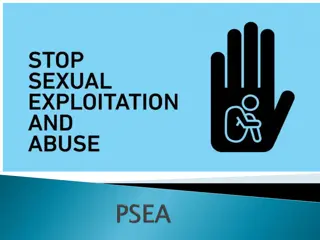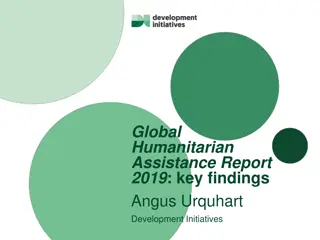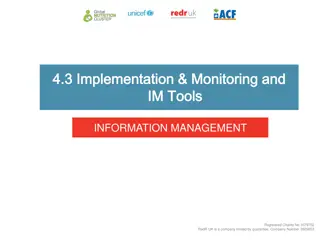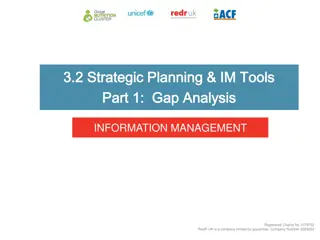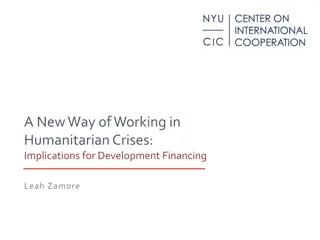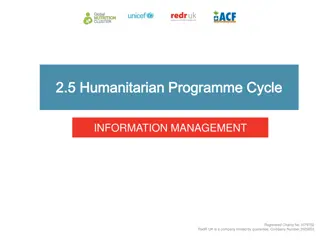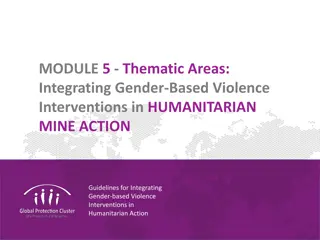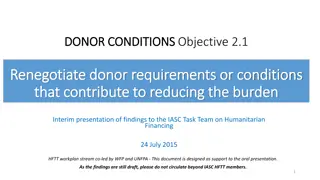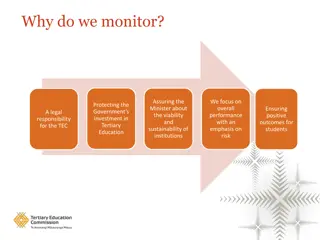Training Program Assessment and Monitoring in Humanitarian Field
This assessment training program focuses on preparing participants for data collection in humanitarian settings. It covers various aspects like welcoming participants, introducing them, setting administrative guidelines, promoting active participation, and outlining teaching methods. Security measures are also discussed for risky contexts. The training emphasizes the importance of participants' roles in the data collection exercise and encourages their best efforts.
Download Presentation

Please find below an Image/Link to download the presentation.
The content on the website is provided AS IS for your information and personal use only. It may not be sold, licensed, or shared on other websites without obtaining consent from the author. Download presentation by click this link. If you encounter any issues during the download, it is possible that the publisher has removed the file from their server.
E N D
Presentation Transcript
ASSESSMENT [Camp/Setting names] Region, Country - Time frame Enumerator assessment training [PLACE, DATES] [LOGO PARTNERS]
Introduction Opening session Welcome to the participants Introduction of participants Administrative/logistic information and guiding rules Presentation of teaching contents and teaching methods Training agenda Assessment and Monitoring Resource Centre
Welcome to participants Speech to welcome the participants Show the gratitude for their participation on the training Explain why is important this assessment exercise for the humanitarian community and the importance of their role on the exercise Encourage them to give their best during the training and during the data collection exercise In case of a difficult/risky context, let them know which security measures have been considered and encourage them to inform their supervisors if, for some reason, they do not feel safe during the data collection exercise. Other key messages
Introduction of participants Invite the participants to present themselves proposing them to answer some questions, for example: Name? Where are they from? Job? Studies? Spoken languages? Experience in data collection?
Administrative/logistic information and guiding rules Provide information about the administrative/ logistic relevant topics and the guiding rules during the training. Example Are all of them already register? What to do if not? At what time the session start and end? Where is the coffee-break? Rules about the use of computers, phones... during the training
How can we actively participate and contribute to an effective training?
Learning and Teaching Methods Indicate which learning and teaching methods will be used during the training, for example: Power point presentations Group and individual exercises Demonstrations Practical exercises Field test Others
Session 1: Assessment objectives and methodology Based on the assessment methodology document explain the next topics: Assessment scope, objectives and timeframe Target population Methodology: level of measurement (community, HH, individual) Methodology: sampling (representative or not representative) Methodology: data collection methods (HH and or individual survey, key informant interviews, observations, focus group discussion)
Session 2: Data collection best practices This session include the best practices for the assessment data collection method such as: Key informant interviews What type of interview is planned to be done ? Structured, semi-structured, unstructured interviews - how to do it? Household or individual interviews What type of interview is planned to be done ? Structured, semi-structured...
Session 2: Data collection best practices Observations: When to do it? By who? Focus group discussion With men With women With children
Session 3 Part I, II and III: Questionnarie and data analysis plan On this session review the questionnaire question-by-question, including all possible responses and the way that each question will be analysed. For each question highlight: Purpose Disaggregation Terminology Possible answers How this data will be analysed and why Ask if training participants have any questions
Session 4 Part I and II: Data collection tools This session includes the steps to follow to use the data collection tool Explain which tool will be used and how it should be used Test the tool with a practical exercise (for this session each enumerator will need access to a data collection tool such as a tablet) Ensure that the current assessment questionnaire is already on the tool Configure the tablets before the session If some participants already know how to use the tool, work with them to support colleagues who have never used the tool before Discuss issues faced during the exercise and answer the participant questions
Session 5: Roles and responsabilites This session includes team composition, roles and responsibilities, reporting and communication lines. Team composition: Explain the assessment team organizational chart ( example on the next slide) Roles and responsibilities: Explain the assessment data collection team TORs Reporting and communication lines: Explain "who" report to "who" and "how" and "when" to do it. Explain how to do it regular reporting (through for example regular meetings between the team leaders and the enumerators) and how to report an urgent or important issue
Assessment coordinator or assessment field coordinator Supervisor 3 Team leader 1 Supervisor 2 Data quality supervisor 4 Enumerators Team leader 2 Team leader 3 Team leader 4 4 Enumerators 4 Enumerators 4 Enumerators
Session 6: Assessment data collection pilot This session should include: What is an assessment pilot? A pilot assessment is a strategy used to test the questionnaire using a smaller sample compared to the planned sample size. Why conduct an assessment pilot?. To improve the assessment tools and approach based on the pilot results: modify, add or remove some questions from the questionnaire, fix any issues identified with the data collection tool and/or improve the data analysis plan.
Session 7: Assessment protocols Based on the assessment protocol document, this session includes instructions about how the assessment will be implemented. Topics to consider are: Respondant selection: who is the target respondant for the interview and how will they be selected Number of revisits: how many times a sampling unit will be revisited before being dropped. Tracking: If a primary sampling unit has moved from the original or anticipated location, identify whether survey teams should track them down
Session 7: Assessment protocols Drops: It is essential that field teams report which sampling units were dropped and why. Replacecement: If a primary sampling unit is dropped, identify whether or not it will be replaced. Use the data collection tool such a tablet: who is responsable of the tool, what to do if does not working during a data colleciton session and when sent the questionnarie to the sever. Focus group discussion Outline processes to select the member of the focus group discussion
Session 8: Additional considerations to implement the assessment data step This session includes additional areas to consider on the implementation of the data collection phase. Some exampleas are: The consent form The code of conduct Security and emergency measures and procedures
Thank you [LOGO PARTNERS]













